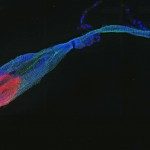Link to Pubmed [PMID] – 9642092
J. Mol. Biol. 1998 Jun;279(5):1163-75
Proteins of the annexin family constitute very attractive models because of their four approximately 70 residue domains, D1 to D4, exhibiting an identical topology comprising five helix segments with only a limited sequence homology of approximately 30%. We focus on the isolated D2 domain, which is only partially folded. A detailed analysis of this equilibrium partially folded state in aqueous solution and micellar solution using 15N-1H multidimensional NMR is presented. Comparison of the residual structure of the entire domain with that of shorter fragments indicates the presence of long-range transient hydrophobic interactions that slightly stabilize the secondary structure elements. The unfolded domain tends to behave as a four-helix, rather than as a five-helix domain. The ensemble of residual structures comprises: (i) a set of native structures consisting of three regions with large helix populations, in rather sharp correspondence with A, B and E helices, and a small helix population in the second part of the C helix; (ii) a set of non-native local structures corresponding to turn-like structures stabilized by several side-chain to side-chain interactions and helix-disruptive side-chains to backbone interactions. Remarkably, residues involved in these local non-native interactions are also involved, in the native structure, in structurally important non-local interactions. During the folding process of annexin I, the local non-native interactions have to switch to native long-range interactions. This structural switch reveals the existence of a sequence-encoded regulation of the folding pathways and kinetics, and emphasizes the key role of the non-native local structures in this regulation.

